|
 Setup
Your Team & League Parameters: (Located on the
Menu Bar Settings
) Setup
Your Team & League Parameters: (Located on the
Menu Bar Settings
)
League: Edit League Settings
League Info | Positions
Most leagues
require you to draft a minimum amount of players by position, the
software will accommodate this. Enter the number of players that you
would like to draft at each position,
include starters only at
each position.
If your league allows "Flex Players", you can select the right
combination that fits your league (as an example if your league allows
for 2 flex players from any of the RB/QB/WR positions, you would
select that combination from the drop down box and enter a 2 in the
space immediately proceeding your selection.)
If you do not use a position, such as individual defensive players,
then enter a Zero (0) in the appropriate corresponding cell.
Fantasy Points System –
This software accommodates league managers that score points based on specific events.
Our flexible scoring section that allows those who play in different types
of leagues to enter their scoring. The 4 exhibits below are provided
to help you determine which type of league you play in. We have
classified the 4 types of league scoring as either Simple,
Bucket, or Progressive.
Exhibit A:
Simple
Scoring Setup (see highlighted area for
explanation)
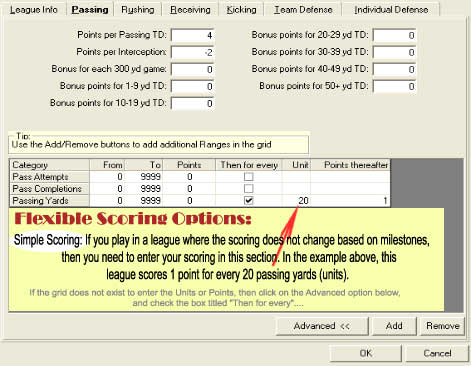
Exhibit B:
Bucket Scoring Setup
(see highlighted area for explanation)
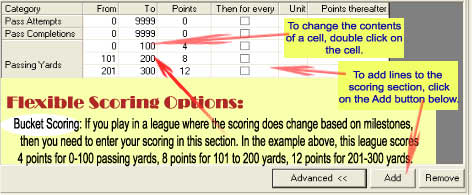
Exhibit C:
Progressive Scoring Setup
(see highlighted area for explanation)
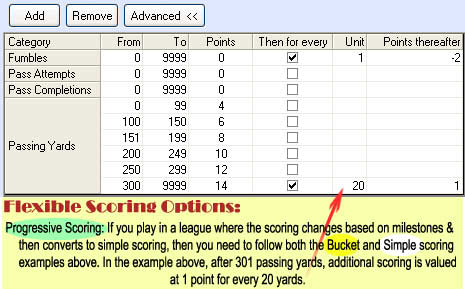
Example
D: Progressive Bonus Scoring League
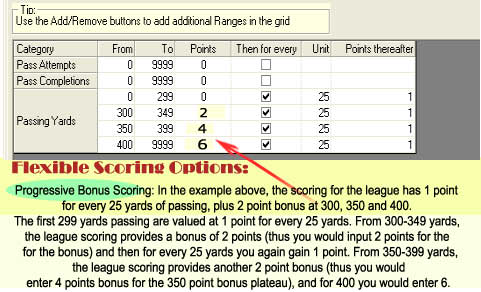
The examples above are for
Passing Yards, you will find these flexible scoring areas in many of
the setup screens. Although the categories are different, the setup is
similar in concept to the screens above.
The
following scoring options are considered basic football specific events for
offensive performance: Passing, Rushing, Receiving, &
Kicking.
|
Passing
Event
|
Comment |
|
Points
per Interception |
Value
Reduction for Interceptions, if you league takes 2
points away for each interception, you would enter "-2"
in this field. (-) |
|
Two Point Conversions |
Points for 2 Point Conversions |
|
Points
per Passing TD |
Points
per Passing TD |
|
Bonus______
Points, |
If
your league scoring stipulates that players gain bonus points
for specific accumulation, we have included a popular benchmark
of 300 yards. 10 points for every
300 yard passing, then input "10"
in the section across from "Bonus___ Points". You can
use this area to input the bonus points or you can use and
specify the ranges in the Passing Yards section below. |
|
For
Every 300 Yard Game |
|
Bonus
Points for 1-9 yd TD |
If
your league scoring stipulates that players gain bonus points
for LENGTH of TD, then input the
additional amount of points ABOVE the basic TD scoring in these
cells. |
|
Bonus
Points for 10-19 yd TD |
|
Bonus
Points for 20-29 yd TD |
|
Bonus
Points for 30-39 yd TD |
|
Bonus
Points for 40-49 yd TD |
|
Bonus
Points for 50+ yd TD |
|
Rushing Event
|
Comment |
|
Points
per Rushing TD |
Points
per Rushing TD |
|
Two Point Conversions |
Points for 2 Point Conversions |
|
Bonus______
Points, |
If
your league scoring stipulates that players gain bonus points
for specific accumulation, we have included a popular benchmark
of 100 yards. 10 points for every
100 yard Rushing, then input "10"
in the section across from "Bonus___ Points".
You can use this area to input the
bonus points or you can use and specify the ranges in the
Rushing Yards section below. |
|
For
Every 100 Yard Game |
|
Bonus
Points for 1-9 yd TD |
If
your league scoring stipulates that players gain bonus points
for LENGTH of TD, then input the
additional amount of points ABOVE the basic TD scoring in these
cells. |
|
Bonus
Points for 10-19 yd TD |
|
Bonus
Points for 20-29 yd TD |
|
Bonus
Points for 30-39 yd TD |
|
Bonus
Points for 40-49 yd TD |
|
Bonus
Points for 50+ yd TD |
|
|
|
Receiving Event
|
Comment |
|
Points
per Receiving TD |
Points
per Receiving TD |
|
Two Point Conversions |
Points for 2 Point Conversions |
|
Bonus______
Points, |
If
your league scoring stipulates that players gain bonus points
for specific accumulation, we have included a popular benchmark
of 100 yards. 10 points for every
100 yard Receiving, then input
"10" in the section
across from "Bonus___ Points".You
can use this area to input the bonus points or you can use
and specify the ranges in the Receiving Yards section below. |
|
For
Every 100 Yard Game |
|
Bonus
Points for 1-9 yd TD |
If
your league scoring stipulates that players gain bonus points
for LENGTH of TD, then input the
additional amount of points ABOVE the basic TD scoring in these
cells. |
|
Bonus
Points for 10-19 yd TD |
|
Bonus
Points for 20-29 yd TD |
|
Bonus
Points for 30-39 yd TD |
|
Bonus
Points for 40-49 yd TD |
|
Bonus
Points for 50+ yd TD |
|
|
|
Kicking Event
|
Comment |
|
Field
Goals 1-29 yds |
If
your league scoring stipulates that players gain points for
LENGTH
of Field Goals, then input the scoring in these cells. IF
YOUR LEAGUE DOES not value length of FG Kick and only values
Field Goals as 1 value, then input that number in EACH of the
"length" cells. |
|
Field
Goals 30-39 yds |
|
Field
Goals 40-49 yds |
|
Field
Goals 50+ yds |
|
Points
for FG Missed |
Negative
Points, start with a "-" sign (-) |
|
Points
for XP Made |
Points
for Extra Points Made |
|
Points
for XP Missed |
Points
for Extra Points Missed, Negative Points, start with a
"-" sign (-) |
|
Team
Defenses
|
Comment |
|
Defensive
TD's |
For
leagues that value Defensive TDs scored. |
|
Interceptions |
Interceptions
gained by the defensive unit |
|
Sacks |
Sacks
gained by the defensive unit |
|
Fumbles
Recovered |
Fumbles
Recovered by the defensive unit |
|
Safeties |
Safeties
by the defensive unit |
|
Team
Defenses
|
Comment |
|
Tackles |
All fields are
Self explanatory |
|
Assists |
|
Sacks |
|
Fumbles
Recovered |
|
Safeties |
|
Passes
Defended |
|
Touchdowns
Scored |
|
Forced
Fumbles |
|
Interceptions |
Important:
for the Setup changes to take effect you must SAVE
before running/viewing the projections or the cheatsheets.
Settings | Fantasy Teams and Budget: If you play
in a private league (not a national contest), enter the
number of teams (owners) that will be participating in your draft.
Add/Remove the number of Teams to you league setting. If
you play in a national contest, we suggest using a default of 12
teams.
You can also name the teams in
your league by double clicking on the Team Name, from here
you can also specify which of the teams is yours by entering in a 1
for your team, all other teams should have a Zero value. If you play in
an auction league: specify your individual team budgets.
Draft Style:
What style of drafting does your league utilize? There are 3
primary styles of play:
Serpentine Draft Order:
Players are drafted in a predetermined order, an order which reverses
at the end of each round. (ie.
1,2,3,4,5,6,7,8,9,10,10,9,8,7,6,5,4,3,2,1). If you select this draft
style, and plan to use the software at your draft, you should also
specify the team order on the FANTASY TEAMS tab. The software will now
expect to draft players according to the specified order. In other
words, when a player is selected to be drafted (right mouse click on
any player name), the software will show the name of the team that is
expected to draft at this point (at the top of the popup box).
If you trade draft slots or need to make alterations you can undraft
the player. You can accomplish this by right clicking on the players
name from the ROSTERS section.
Non Serpentine (straight) Draft Order:
Players are drafted in a predetermined order, an order which
repeats at the end of each round. (ie.
1,2,3,4,5,6,7,8,9,10,1,2,3,4,5,6,7,8,9,10).
Auction Style Play:
For those who play
in a league that uses an auction system, this option will facilitate
your needs. Selecting this option will allow the software to value
players based on your budget constraints. After this option is
selected, a new tab called ADVANCED will appear on the Setup Page. The
ADVANCED tab will contain an additional options (see below) for this
style of play.
Settings |Auction League Setup:
Dollar Allowed: enter your team budget here.
Minimum Bid
Value: If you play in an auction league, enter the Minimum
bid amount in this area.
Expected
Auction Value (EAV) is an
algorithm developed to mimic the non linear decline in auction prices
during the span of a draft. Its primary function is to aid those
who participate in an auction draft.
For more on EAV,
click here
Budget Allocation
Split:
Again for auction leagues, some
fantasy GMs like to specify the amount they believe the league will
spend on the various positions. We've set the default Splits based on
the Typical 12 team league (1
point for 10 yards rush/receiving, 1 point for 20 yards passing, 6
points for rushing/receiving TD, 4 points for passing TD).
The result of this split will shift
the EAV$ for each player. If you feel that the EAV results for the
players are unreasonable, you can manually change the allocation of
the budget (check box) to better quit your taste. The only limitation:
the Total must equal 100%.
Max Player $
Value:
This area is is being phased out,
as the Budget Allocation Split overrides this function. Ignore this
section.
Settings | Program Settings:
Display Options | Draft Option: Hide
Drafted Players (only option) after selected to roster (right mouse
click on any player and selecting him to a team roster).
Display Options | Cheatsheet
Display - We suggest that you use Fantasy Points (FP) in Draft style
leagues, and Expected Auction Value ($EAV) in Auction type drafts.
Display Options | Rank Based on - We
suggest that you use Fantasy Points (FP) in Draft style leagues, and
Expected Auction Value ($EAV) in Auction type drafts.
Display Options | Program Settings:
After drafting a player view to enter cost, should only be selected in
Auction Style leagues.
Display Options | Program Settings:
Color Cheatsheets should be selected if you have a color printer, as
it will show player quality in colored tiers (the darker color the
better the player).
Creating
Multiple Teams for different Leagues:
Leagues
(Located on the
Top Menu Bar Leagues
)
Select Different League / Create New
League: Enter your new team name and setup your league
parameters to your needs.
 Viewing
the Fantistics Projections Viewing
the Fantistics Projections
Projections (Located on the
main screen)
Here is where you will find all of the
Fantistics Football Player Projections (registered users only) for the
upcoming season. The projections are sorted by Fantasy Points (FP) and can be sorted as
per your desire (see Sorting). Each of the
positions are located in separate "sheets",
viewable by clicking (left mouse button) on the tabs located in the
top section corner of the screen. These projections
are updated throughout the preseason for registered users, so be sure
to check for web updates on a frequent basis (see Web
Update).
Sorting
the Fantistics Projections
Sorting
Sorting the projections by your
desirable criteria can be done by clicking (left mouse button)
on the header line showing the stat category you are interested in. For instance if you want to sort by
Rushing Yards on the RunningBack page, click "left mouse button" on
the (Rush) cell.
Stat Categories (To Select to
View: Right Mouse click on the Stat Row in the Software)
|
Category |
QB |
RB |
WR/TE |
K |
Team D |
IDP |
|
Bye |
Bye Week |
Bye Week |
Bye Week |
Bye Week |
Bye Week |
Bye Week |
|
Sch |
Schedule of Difficulty
|
Schedule of Difficulty
|
Schedule of Difficulty
|
Schedule of Difficulty
|
Schedule of Difficulty
|
Schedule of Difficulty
|
|
P-Sch |
Playoff
Schedule Grade W 15/16 |
Playoff
Schedule Grade W 15/16 |
Playoff
Schedule Grade W 15/16 |
Playoff
Schedule Grade W 15/16 |
Playoff
Schedule Grade W 15/16 |
Playoff
Schedule Grade W 15/16 |
|
OL |
Grade of Offensive Line |
Grade of Offensive Line |
|
|
|
|
| Att |
Pass
Attempts |
|
|
|
|
|
| Comp |
Completions |
|
|
|
|
|
| Pass YD |
Passing
Yards |
|
|
|
|
|
| QB Int |
Interceptions |
|
|
|
|
|
| Pass TD |
Passing
TDs |
|
|
|
|
|
| Comp % |
Pass
Completion % |
|
|
|
|
|
| Fumb |
Fumbles |
Fumbles |
Fumbles |
|
|
|
| 2 PT |
Two
Point Conversions |
Two
Point Conversions |
Two
Point Conversions |
|
|
|
| Rush Att |
Rush
Attempts |
Rush
Attempts |
Rush
Attempts |
|
|
|
| Rush |
Rush
Yards |
Rush
Yards |
Rush
Yards |
|
|
|
| YPRU |
Yards
Per Rush Average |
Yards
Per Rush Average |
Yards
Per Rush Average |
|
|
|
| Rush TD |
Rush TD |
Rush TD |
Rush TD |
|
|
|
| TDs |
Total
TDs |
Total
TDs |
Total
TDs |
|
D TD:
Defensive TD Scored |
All TD:
Defensive TD Scored |
| Rec Comp |
|
Receiving Completions |
Receiving Completions |
|
|
|
| Rec |
|
Receiving Yards |
Receiving Yards |
|
|
|
|
Rec TD |
|
Receiving TDs |
Receiving TDs |
|
|
|
| YPRE |
Yards
Per Receiving Average |
Yards
Per Receiving Average |
Yards
Per Receiving Average |
|
|
|
| 300/100 yrd |
# of 300 Yard Passing Yards
Expected |
# of 100 Yard Rushing Yards
Expected |
# of 100 Yard Receiving Yards
Expected |
|
|
|
| FP |
Fantasy Points based on your
scoring rules |
Fantasy Points based on
your scoring rules |
Fantasy Points based on
your scoring rules |
Fantasy Points based on
your scoring rules |
Fantasy Points based on
your scoring rules |
Fantasy Points based on
your scoring rules |
|
EAV$ |
Expected Auction Value for
Auction Leagues |
Expected Auction Value for
Auction Leagues |
Expected Auction Value for
Auction Leagues |
Expected Auction Value for
Auction Leagues |
Expected Auction Value for
Auction Leagues |
Expected Auction Value for
Auction Leagues |
|
INF$
(Details below) |
Inflation Adjusted Value for
Auction Leagues* |
Inflation Adjusted
Value for Auction Leagues* |
Inflation Adjusted
Value for Auction Leagues* |
Inflation Adjusted
Value for Auction Leagues* |
Inflation Adjusted
Value for Auction Leagues* |
Inflation Adjusted
Value for Auction Leagues* |
|
VAM
(Details below) |
Value Above Mean* |
Value Above Mean* |
Value Above Mean* |
Value Above Mean* |
Value Above Mean* |
Value Above Mean* |
|
ADP |
Average Draft Position |
Average Draft Position |
Average Draft Position |
Average Draft Position |
Average Draft Position |
Average Draft Position |
INF$ Inflation:
This is technique is applied to account for players
who were “keep or protected” in keeper leagues at values below Fair
Market Value ($EAV) or can be used during a draft to guage under or
over spending. In theory this means that the remaining
players, especially the top players remaining to be drafted, will
increase in auction value. The purpose is to increase the EAV$ of
the top players while maintaining the same budget.
As a formula, Draft Inflation is: ((Original League Budget)-(Frozen
prices of all kept Players))/((Original League Budget)-(Fair Market
Value of kept Players))
Let's assume that the league budget is $2,600 ($260 times 10 teams)
and the Frozen Prices paid of let's say 30 players is $300, with a
Fair Market Value of $800. Then:
(2600-300)/(2600-800)= 27% Draft Inflation
So in theory, there was a discount of 27% paid for the kept players
based on the overall budget. Since our goal is to spend all of the
budgeted dollars, this increases the value of the each remaining
players (a finite number).
Important: for
the Setup changes to take effect you must SAVE
before running/viewing the projections or the cheat sheets.
Selecting Players to Roster
during a Draft: Right mouse click on a
player and select him to a team.
Locking
out "Keeper players"
or players not included in your
Draft
If your league allows you to keep
players from year to year, select the player to a roster (see above)
and from the rosters menu, right click on the player to engage him as
a keeper. This will also allow you to run unlimited mock drafts
without having to re-enter keeper players.
 Updating
your
Fantistics Preseason Projections (Must
be online) Updating
your
Fantistics Preseason Projections (Must
be online)
Our
goal is to not only provide you with the best projections but also
provide you with the most up to date fantasy projections found
anywhere! As we get closer to the season you will find that the
fantasy projections are updated on a daily basis. Early projections
may change considerably for younger players as their playing time may
be dependant on the events of training camps. We recommend that you
use our web update feature before your draft.
Open up the Web Update popup
window and enter your Fantistics Football ID and password, and click
the check box (which will save your ID and password for future uses).
Now click on the "Check for Update" button (you must be
connected to the internet), if a new version of the projections
database exists, you will be notified in the pop up window, and the
software will being to update. After the software
downloads (see progress bar on the screen) it's a good idea to
close all the windows that are open within the program.
As a registered user, you can find
the latest date of the database that you are using by viewing the
lower left hand corner of the program.
Important:
You must
enter your ID and Password that was assigned by you when you purchased
the Fantistics Football package, this is the only way to receive the
latest version of the projections. If you forgot/lost your ID &
password, click
here to enter your email into our automated password system, it
will be sent to you via email (you must be connected to the
internet to use this option).
 Draft Section:
Rosters Draft Section:
Rosters
Player Roster
League Draft
Roster (Grid of Fantasy Teams)- Select a player to
the rosters grid in one of the following manners: From any of the
following pages/tabs (Projections, Top 100 VAM, or Search Pages)
you can
right mouse click a player to a team.
Depending on your League Setup
(see
Setting your Team & League
Parameters), you
can select players to a roster in:
Change a player's draft cost
by double clicking on the players name.
You can move a player back to
the list of available players by right mouse clicking a player from
the roster and selecting a new team. You can also "Undraft"
the player.
As players are selected their
names as well as their statistics will be removed from
the viewable player universe.
You have the ability to choose the
columns that you would like to see during your draft on the
rosters page. You can select the columns (Fantasy Points, Cost, Bye) you would like to see in the League Draft Roster (see below).
Printable Report
:After your draft is complete you can print your league draft.
** When you begin
propagating the rosters section, please be aware that it will change
the Projections as well as the cheat sheet pages as players are
selected to various teams and are no longer available in the player
universe.
***When you are ready
to draft your team, be very sure that you have the correct setup prior
to selecting players, as saving any changes in the setup section can
sometimes
clear the rosters.
Draft Totals (bottom of the rosters page)- The draft totals at
the bottom of the page will give you the quick stats that you'll need
to make decisions with.
#Drafted:
The number of players selected, in brackets are the reserves.
#Needed:
The number of players needed, in
brackets are the reserves.
FP:
Total Fantasy Points for each team
Player Search
Use the Player search (upper right hand corner to quickly locate players, either
in your draft preparation or on draft day. If you do use the software
during your draft, you can also drop and drag players to the rosters
page (or right mouse click)
 Mock
Draft Module
Practice
your drafting Skills Mock
Draft Module
Practice
your drafting Skills
Get
your Mock on...this module is undoubtedly the most addicting fantasy tools we've
ever created! For the first time fantasy GMs can simulate their
fantasy draft before draft day using their specific scoring rules.
More importantly you'll be able select players at your own pace,
instantly seeing the scoring ramifications of the decisions you make,
test the Fantistics Draft Strategy ( VAM) and valuations (FP
- Fantasy Points), while
honing your drafting skills....and you won't have to spend 3 hours
doing it (pause your draft at any time or just walk away).
The
new Mock Draft module, within the Fantistics Player Projections
program, allows fantasy GMs to practice drafting skills
using our recommended
VAM draft strategy. The
opponents' (automated computer selectors) will be using ADP.
ADP or Average Draft Position represents an accumulation of
fantasy drafts throughout the fantasy football
community. We collect this information every week during training
camps and update ADP accordingly. The Mock Draft module also allows
us to use the "true"
VAM draft strategy, were we
recommend switching to player valuation (FP
- Fantasy Points)
after the first 90-100 selections of your draft. With this mock draft
feature you are free to decide when you would like to switch from the
VAM strategy or not switch (if you choose.)
Other
draft strategy options you can select as your strategy include Fantasy Points (if fantasy points is selected in Setup area) or
ADP (In most cases you will experience that our
VAM
strategy produces the most optimal results.)
Options include 1. Drafting starting positions before reserves
(recommended), and 2. Having the program stop before your selection
(allowing you to make selections, instead of the selected automated
strategy).
We
recommend that you open the Rosters tab and the Draft Summary tab,
prior to running your mock draft. Having these windows open will allow
you to toggle between the screens, allowing you to see how your team
is shaping up verses your opponents, and more importantly: how your
team is accumulating fantasy points or Roto points verses the
competition (see Draft Summary).
If you
have selected Keeper players from within the Setup | Draft Order
area, then these keepers will not be removed when you clear the
mock draft results from the Mock Draft area. The only way to clear
these keepers is from the Setup | Draft Order area.
Auction Mock Draft Simulation:
Although VAM is the
definitive draft methodology recommended for Serpentine/non auction
drafts, Auction drafts are heavily influenced by the difference
between the actual auction price and the expected auction value.
Obviously, there is no way to capture this through a simulation.
However, budget allocation strategies can be simulated.” VAM Budget”
allows you to test different spending methods for your team while
adhering to the league budget. If for example you would like to avoid
a high/low spending strategy, you can set the simulation to draft the
10-12th listed player according to VAM for the first 80 or so
players. This will allow your team to take a more balanced approach.
Draft Advisory
Top 100 VAM

Our suggested
draft order based on your league scoring for the top 100 players
sorted by VAM.
Players can be selected directly from the Draft
Advisor list and placed on a roster (either by using the right mouse
button or drop and dragging). As players are selected the next
best available players move up the list.
VAM:
We pride ourselves with not necessarily picking the right guy, but with
picking the right strategy. After we compute our projections for the
upcoming season,
the software derives the
VAM ranking
list using mathematical means to produce the best outcome. Not only
does the software consider position scarcity (which is specific to you
league and scoring), but it also considers the probability of
predictability related to each position (see
Draft Research). While the fantasy
community has caught up with the basic understanding of the position
scarcity theory (RBs ranked highly), they haven't quantified it, which continues to leave
there fate based on luck. Our draft strategy is predicated on the theory
of probability and given enough of a sample size, the theory flat out
kicks butt. Consider the theory behind one of the riches gold mines in
America: the Gambling Casinos. Sure once and a while, someone comes out
winning, but given enough action, the Casinos win overall...the Theory of
Probability. That's not to say that you will not finish the season with a
uncompetitive team, even if the theory was 99% valid, there is always a
chance that the number of players selected (sample size) was not large
enough and you are unfortunate enough to draft all the guys that have a
disappointing or injury plagued seasons...but again, using the strategy
the odds are in your favor...and that really is the best anyone can hope
for. Stick with the VAM ranking list through the first 80-100
selections of your draft, if you play in a conventional league, ignore the
Kickers, Tight Ends and Defenses until the later rounds. Using the VAM
ranking you'll likely miss out on a few of the upper end Wide Receivers
(as some may select these guys too early in your draft), but that's ok and
part of the strategy, as receivers have a poor correlation of
predictability and many mid level receivers step up year after year.
Additionally unheralded Wide Receivers, Tight Ends, Kickers, and Defenses
are almost always available during the season in the free agent market
(and you'll know about these guys from us). How often do quality running
backs and quarterbacks who went undrafted produce big numbers? Very
infrequently...unless an injury happens to one of the starters. If you
have open reserve slots, make sure that they are filled up with running
backs and maybe a quarterback or two...as you can never have enough of
these high commodity guys.
Average Draft Position (ADP) - We update the projections software throughout the
preseason with a new indicator called Average Draft Position (ADP).
ADP will represent an accumulation of drafts throughout the fantasy
football community. The average draft slot where the NFL players are
selected will then be converted to your specific league setting. Thus
if your league for instance has 8 teams, the NFL player drafted 9th nationally
would appear as 2.01 in your software (2.01 represents 1st slot of the
second round).
Since disadvantaged fantasy football GMs use generic cheat sheets, it's an advantage to
not only have rankings that are tailored to your league, but also to know the sentiment of the general
fantasy community. Using this new tool you'll be able to ascertain the
possible mindset of those around you. One possible use of ADP is
delaying the drafting of a player who we hold in higher esteem until a
later round. You can view the cheatsheet with their ADP ranking by
selecting Setup|Edit League Settings|Cheatsheet
Display Option: ADP
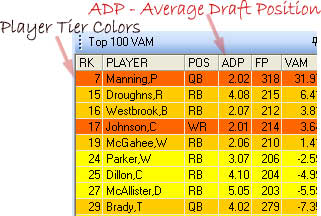
Expected
Auction Value (EAV)
is an
algorithm developed to mimic the non linear decline in auction prices
during the span of a fantasy draft. Its primary function is to aid those
who participate in an auction draft.
As long time fantistics subscribers
already know, our "$ values" have and still do represent the value of that players
potential return to your fantasy team at the end of the playing
season. In the past, we made a concerted effort to make sure that our
subscribers understand that each and every auction has a unique
outcome and the prices paid are subject to the same forces that
permeate any live auction, supply and demand.
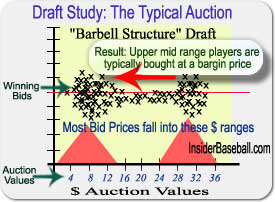
For the first time, we are presenting a
calculation based on your league settings where we attempt to mimic
what the auction bidding will be like during your draft. Since the
natural laws of supply and demand are still unpredictable to an extent, the values presented
in EAV will represent an approximation based on the
typical bidding pattern of most Fantasy Football Drafts. EAV or
Expected Auction Value is based on our study which analyzed the results
of 200+ completed auction drafts. Our auction
draft data collection includes results from national contest drafts,
private drafts, and public drafts. Private League drafts included
leagues that ranged from 6-24 GMs and scoring setups that were based
on Fantasy Point leagues. In the
end, we found that most drafts fell into one of three patterns.
The Typical Bidding Draft -
In this type of bidding environment, most of the top players are sold
at reasonable or full projection valuation, which leads to the typical
amount of bargains in the middle and late stages of the draft. This
type of bidding is most typical in private leagues that are managed by
seasoned GMs.
The Conservative Bidding Draft - In this type of bidding environment,
most of the top players are sold at a discount, as a good number of
GM's are looking for bargains. This typically leads to the
bargains in early portion of the draft as top players (top 5%) are
selling at a discount greater than 10-15%. This leads to higher than
expected winning bids on the mid to late round players.
The Aggressive Bidding Draft -
In this type of bidding environment,
most of the top players are sold at a premium as an assertive majority of
GM's are infatuated with the top players. This typically leads to
bargains in the latter portion of the draft as early mid quality players
are selling at a discount greater than expected. This also leads to lower
than expected winning bids on the mid and late round players due
to the money drain on the top players.
What type of auction will you be
in this year? If you have a history with the same GMs, what has your
auction been like in the past? If you have last year's auction draft
info, then it's a good idea to look back and see how your league typically bids.
The good news is that none of the three EAV options will be
dramatically different (only a 10-15% difference for a mid tier player.)
Using this tool, you should be able to conceptually find bargains based on the computed fantasy $ valuation, the
Expected Auction Value and the current bidding level.
 Draft Section: Draft Summary Draft Section: Draft Summary
Detailed Draft Totals also showing
the accumulated team totals for your leagues scoring categories.
The Roto Column/Section is designed for
leagues where player stats are
combined and compared verses other team owners and point values are
given according to a ranking system.
 Using
The Cheatsheets (Draft Ranking Lists) Using
The Cheatsheets (Draft Ranking Lists)
CheatSheets (Located on
the Menu Bar
Reporting | Cheatsheets)
The Cheatsheets or Draft Rankings
lists are the pages that many of you will be using on your drafting
day. The player names are organized by their primary expected position
for the upcoming season.
To the left of the players
name is a ranking by position, to the immediate right is his current
team followed by the player's off week (Bye week, ie. B5 = Week
5) and the computed fantasy point value according to your setup
parameters.
The last column of the
cheatsheet is a ranking according to our recommended draft strategy
VAM, (click here for more on VAM).
Lastly you will notice that
some players are Zeroed out the cheatsheet, this does not mean that
they will not produce any value, it just means that they will not
likely be drafted based on your league parameters that you have setup
(if you have a limited number of roster spots the players above these
guys will get drafted first, making it unlikely that they will be
drafted).
 Printing
The Cheatsheets (or the projections) Printing
The Cheatsheets (or the projections)
Printing
(Located on
the Apple Program Menu Bar File | Print )
Printing the Cheatsheets is simple All
that is necessary is for you to have the cheatsheets window active,
and then click on the Apple Program Menu Bar File | Print
Some may also choose to print the
projections, which be warned may be as long as 20-25 pages. To print
the projections, just have the projections window active "left
button mouse" click.
If you have a color printer, the
cheatsheet will print a color coded cheat sheet. This color coding is
based on player tiers. See
Draft Advisory
Player Tiers
for more information on how the tiers work.
Export the Cheat-sheets to Excel
Exporting
the cheat sheets to excel is currently disabled for the mac
product, but we're working on this.
Understanding the Intelligence Data in the top
section of the Projections Page
The Graphical Charts:
Roll
over a player stat and see his 4 year and 2006 2nd half history and
projection in the upper left hand corner of the
projections screen. These graphic charts give you an easy view of how
the player compares against his peers (green bars), as their averages
are also charted
(based on the number of starters for each
team at each position). If you use
the program during your draft, deciding between players could be as
easy as a roll of the mouse. Seeing an established player's key
categories on a decline or rise could be as powerful as any
statistical indicator.
Use these charts as an indication tool
when evaluating the risk of a player. The VAM Chart measures the value
of a player when compared to the overall value of all the player
positions. So even though a player, such as a kicker, is atop in his
position, his overall value may be below the VAM baseline.
(Tip: To view different player history use the
tab or the mouse to select new players in the projections section)
The Advanced Historical Stats:
Many of the indicators listed up top on the Projections Page, are some
of the most widely recognized stats used by football analysts (2013 P
is our 2013 Projections, 2006 2H is the players results from the last
8 games of the 2006 season):
|
Pass YD |
Passing Yards |
|
ATT |
Passing Attempts |
|
Int |
Interceptions Thrown |
|
Rush |
Rushing Yards |
|
YPRU |
Yards Per Rush |
|
Rec |
Receiving Yards |
|
YPRE |
Yards Per Reception |
|
TD's |
Total TDs, Includes Pass, Rush, or Receiving TDs |
|
100/300 Yrd |
Signifies how often these milestones where met |
|
Red Zone |
Signifies how many times the player was given an
opportunity to carry the ball inside an opponents 20 yard line. |
|
Red Zone Percentage |
Signifies the successful number of Red Zone
carries (carries within the 20 yard line that lead to a score for
the player) |
|
Target |
Signifies the number of times a receiver was
targeted with a pass thrown. |
|
Comp % |
Completion Percentage |
|
QS |
Quality Starts - Signifies the number of games
that the player posted better than average fantasy points during
the season. |
|
Schedule |
Rates (an average of) the opposing defense that
the player faced or will face during the season |
|
Production |
Signifies whether a player/defensive team improved
(increased/decreased) his/their average per game output from period to
period (or is expected to increase or decrease based on our
projections) |
Player Notes:
Here you will find information
critical to your knowledge base for draft day. It will contain
historical statistical achievements achieved over the last 3 seasons.
Reading the player notes and glancing at the charts will give
you an idea how some of these indicators influence other key fantasy
numbers. PPG - Fantasy Production indicator measures a players average
Fantasy output per game.
Exporting
The Projections to Excel
(currently not available, but may be in future release
)
Good Luck in your Draft!
The
Fantistics Projections
(Written
by Fantistics Statistician Anthony A. Perri)
"I'm sure
you've read other website claims offering an "80% accuracy
in predicting Fantasy Football Draft Day Statistics"....that statement is about as
realistic as the guy with the snake skin boots (on the back of that weekly
football journal) offering 100% accuracy in picking the winners of
this week's NFL games! "
During the decade that we've been
forecasting fantasy statistics, fantasy football is, by far, the
toughest sport to forecast of the 4 major U.S. sports.
Possible explanations abound, but logic dictates the most likely
explanations for this phenomena are:
- The limited size of the sample
in any given year (16 games) ,
- The rather high occurrence
of injuries, and
- The dependence on other position
players & the coaches playbook.
The Limited sample size:
To produce any meaningful forecasting data, professional
statisticians consider 100 observations to be the minimum
acceptable size of a sample. As you can imagine, 16 regular season
games falls well beneath that threshold. However the cumulative number of
observations within a game can constitute meaningful data. An
example of this is an average running back who attains 300+ carries in
a season. Although the results of these numbers are meaningful,
they are skewed by the only 16 (or less) different opponents that
a particular running back faced during the season.
High Occurrence of Injuries:
For anyone who has not played or watched football....football is a brutal full
contact sport....with lots of injuries! And more importantly no
one can predict injuries. Thus relying on a drafting model
(cheat sheet) which is purely based on individual performances is missing the bigger picture.
Dependence on other Position
Players & Playbook: In baseball a
batter comes up to the plate and takes a full hack 95% of the
time, while the opposing pitcher is looking to record an out
almost 100% of the time. In football however, almost every offensive position relies on other
factors, outside of their immediate control, in order to produce fantasy success.
Examples include: a running back who relies
on his line to find an opening, relies on his coach to call the
play....a quarterback who relies on his offensive line to give him time, his
wide receiver to find an opening, his coach to call the play....a
receiver relies on the quarterback to find the time, his
quarterback to find his hands, and finally the coach to call the
play. As you can see there are a lot of variables that need to
work in sync for our fantasy players to perform adequately. Thus,
because of this dependence
factor, predicting individual performances in fantasy football is
much less predictable as many will have you believe.
The
key to being competitive, is knowing how to draft. Our
VAM drafting model puts you in a position to be competitive
without the improbable accuracy of the projected player stats.
Sure we spend months working on individual projections, and
our projections model is 35%+ more effective than using the prior
year stats, but it's the drafting order that we predicate which
will make you competitive. Bottom Line: We do the tedious work,
so you don't have to! Whether you are a new or experienced fantasy
football player, Fantistics has the edge.
Below is a quick
look at some of the forecasting research we've done based on
prior year statistics. It's just part of the what we use in our
projections model:
|
Quarterback
predictability has dropped over recent seasons. 2007 was first year since 2002 when less than 50% of the top 20 QBs
scored within 30% of their previous season totals. Of the top
20 QBs from the 2008 season, 12 came within 30% of
their previous season totals in 2008. However, since
position scarcity among the QB position is not an issue in most
leagues, selecting a QB early is only a consideration for 3 QBs in
the first 3 rounds of the 2013 season. |
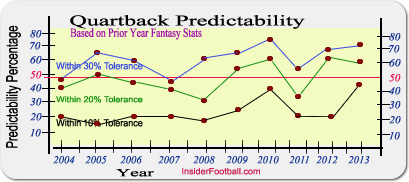 |
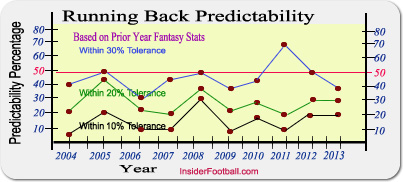 |
Once again, Running Backs offer more
stability to the fantasy roster than other significant positions.
From a forecasting viewpoint, last season 35% of the top 20 RBs
from the 2008 season came within 10% of there pervious season
totals. That is the most stability that you'll find in the first 2
rounds.
RBs
offer stability based on their dependence factor, or should we say
independence factor. |
|
Wide Receivers
DO NOT offer significant stability. Since 2002 less than
50% of Wide Receivers have come within a 20% tolerance of their previous
season's fantasy points. Last year 7 of the top 10 WR failed to
come within 75% of their previous season totals! Although wide receivers do
offer more predictability because of their health factor,
receivers are highly reliant on someone else (the QB), and are
rated accordingly in our projections. |
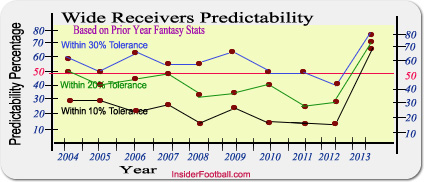 |
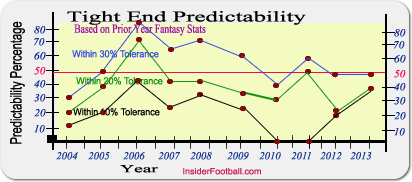 |
Tight Ends have
become increasing more predictable. Last year was a banner
year for the top 10 TEs. 70% came within a 30% tolerance of their
previous season's output.
The main reason
for their lack of predictability in the past has been all of the main 3
factors.... Dependence, Injury and Play book.
|
|
Place Kickers are
very predictable!
Although their 60-80% reoccurrence rate (within a
30% variance) are among the best relational numbers in fantasy
football.... these numbers are also very deceiving. The reason that most
kickers fall within acceptable ranges on a year to year basis is
primarily due to the fact that kickers are among the lowest
scoring positions in fantasy football, thus frequently there is
not much point variance between the 6th best kicker in the league and
the 15th. |
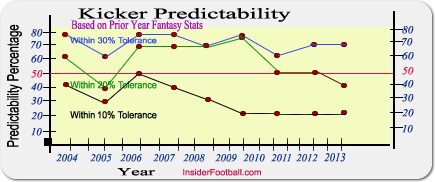 |
|
So
what does this all mean? Well most importantly, it allows
us to assign a probability to each NFL position for draft day
purposes, making the
VAM
drafting model more predictable than a simple position scarcity
model. |
|
 The
Fantistics
Draft
Strategy VAM The
Fantistics
Draft
Strategy VAM
|